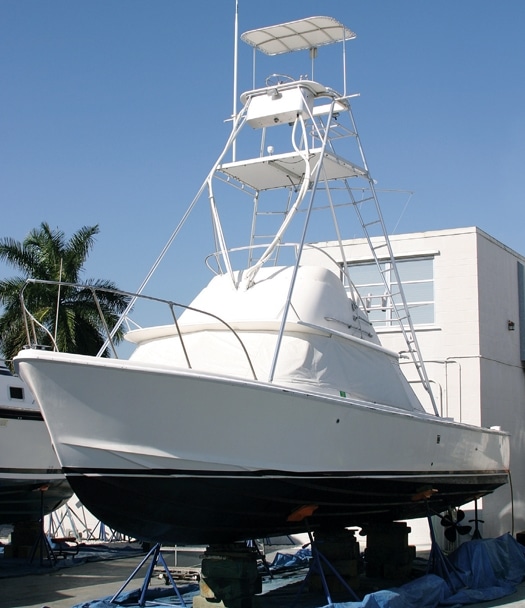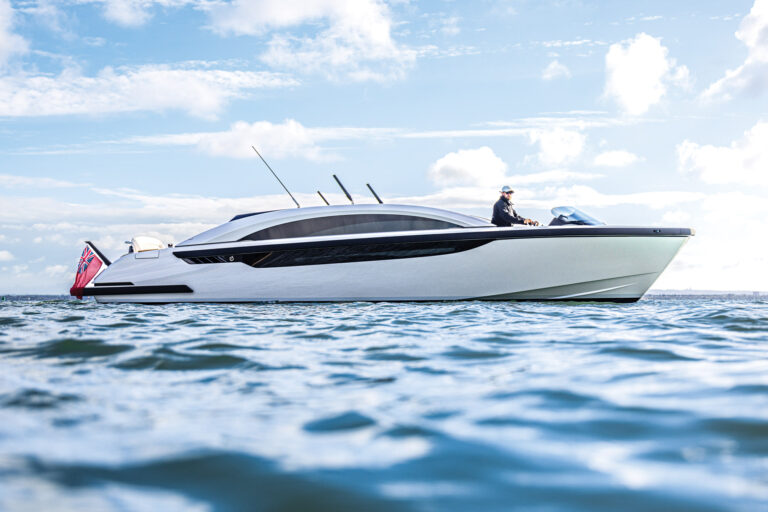
ytgjan4yy525.jpg
Hauling your yacht for the season, or even for routine maintenance, is never a joyous occasion-after all, a yacht on the hard is not on the water, and neither are you. But you can make the most of this “time out” by thinking like a surveyor. If you take care of everything at once, this dry season may allow you to extend your pleasure aboard, once your yacht is re-splashed.
Sight and Sound
**** Begin your survey by standing several yards away from your boat and simply looking at it. Are its lines symmetrical and true? As you walk around the boat from a distance of a few yards, look for flat spots, bumps, scratches, and any indications of collision damage. Take notes as you go. Now, move in and repeat your hull inspection at a closer range-say, a foot or so. One technique used by surveyors is to inspect the hull’s “horizon.” To do this, start at the bow and look along the hull’s surface, paying attention to the line of the hull against the distant background. Then walk along the hull, keeping your attention on the hull line. Dents and soft spots will reveal themselves this way. (Bumps and blemishes are much more visible on dark hulls than on light.)
Sound out the hull with a hammer-one with a plasticand- rubber head. (Such soft hammers are available from any hardware store for a few bucks.) Walk around the boat lightly tapping and listening to the nice hollow sound. Be alert for any tap that returns a dead thud-that’s what you’re looking for. If you find such an area, sound out its edges carefully and circle the area with a grease pencil for later attention. Keep in mind that areas in which bulkheads or stringers butt up against the glass hull (called “hard points”) will sound solid when tapped. That’s normal.
Paint by Numbers
If your yacht’s bottom paint is chipping, you’ll have to scrape and sand before painting again in the spring. Be sure to get the yard’s permission if you plan to prepare the bottom yourself. State and federal governments have all sorts of requirements for the disposal of hazardous materials, and old bottom paint falls into this category.
“If you’ve got a lot of growth, it’s obviously the wrong kind of paint or it sat out of the water too long before relaunching,” says Don Patton of Patton Marine, Inc., in Miami. “When a boat gets “paint-sick” it’s pretty easy to see. The paint will be flaking and you can see where it’s been patched up before and it just gets to a certain point it needs to be removed, and a new system put on in accordance with the manufacturer’s instructions.”
If your boat has 10 or more years of old bottom paint, you may want to consider having all of the paint removed. The yard can find a contractor to blast the bottom for a reasonable price. These contractors employ various cleaning methods using “soft” abrasives, including walnut shells and manmade materials.
One warning: Before you blast the paint off an aging boat-be prepared to deal with whatever the operation uncovers. At the very least, you’ll have to reseal the bottom with an epoxy-based material and take care of any blisters and blemishes. Once you have resealed the bottom, consider using ablative bottom paint as you move forward so layers don’t build up seasonally. If your hull inspection and sounding turned up any dead spots, call in a professional, such as the local fiberglass-repair guy, for a second opinion. If there is damage present, get it done as winter work if you are in colder climates. The rates are normally lower than in-season work and you won’t lose any boating time next spring.
Running Gear Run-Through
Finally, inspect the underwater gear. If your boat is an inboard, eyeball the struts, shafts, and props. They should be clean (no barnacle scars), symmetrical, free-turning, and undamaged. Pay special attention to the cutlass bearings. Make sure the rubber-compound bearing inserts are present and not flattened at any point.
The propeller edges should be free of nicks and bends, and the surfaces should be clean. Nicks or stress risers should be removed professionally to maintain dynamic balance. Bends in the leading and trailing edges can disturb efficiency and thus sap speed and increase fuel consumption. Flaws on blade surfaces can effect boundary layer flow and, therefore, efficiency. Most propeller shops offer a winter reconditioning package that includes cleaning, balancing, resurfacing, and re-edging. This service is usually a real cost-benefit bargain. When reinstalling props, be sure to grease the propeller shaft.
If your boat is on the hard for the winter and shrink-wrapped, you can ask the yard to install a door in the shrink wrap-usually for less than $100-so you can access the interior and work (or hide out there) on warm winter days. Be sure to keep your workspace safe and well ventilated, and that means no painting or glass work. If you are working in the engine compartment, it’s best to roll back the shrink wrap to open the entire area to fresh air.
While I don’t want to sound like your mother, take care when you are working in the yard during the winter months. Tell someone where you’ll be and what you’re doing. Be especially careful with ladders and climbing around the deck of a blocked boat. It’s a long way from the deck to the hard surfaces below.
And with all the hassle of hauling out, why not take care of everything at once? “If you’re going to haul your boat on your own, maybe because you have to scrape the bottom or you want to look at damage or something, always call your insurance company so they can send a guy out if required and do an out-of-water survey,” says Patton. “They’ll want an in-the-water survey as well.”
To learn more about Patton Marine, Inc., visit _www.pattonmarine.com_.








